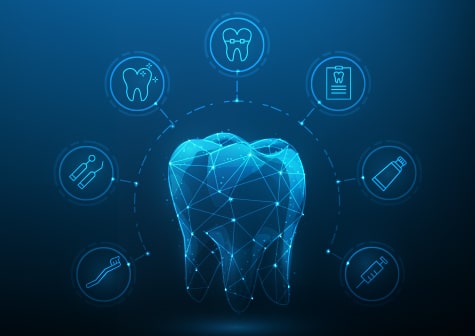Oral cancer affects thousands of individuals each year, often going undetected until it reaches an advanced stage. Early detection can save lives, and now, cutting-edge dental technology advancements are paving the way for improved outcomes. One of the most promising tools in this effort is artificial intelligence (AI). This blog explores how AI in oral cancer detection is transforming the landscape of oral health screening and enhancing early diagnosis.
Understanding Oral Cancer
Oral cancer refers to malignant growths in the mouth or throat, including areas such as the tongue, cheeks, lips, and gums. According to health organisations, key risk factors include tobacco use, excessive alcohol consumption, human papillomavirus (HPV), and prolonged sun exposure for lip cancer.
The Importance of Early Detection
Early-stage oral cancer is more treatable, with survival rates significantly higher than when diagnosed later. Symptoms can be subtle, often mistaken for less serious conditions, which underscores the need for precise and timely oral health screening.
How AI is Revolutionising Oral Cancer Detection
Artificial intelligence leverages machine learning and deep learning to analyse vast amounts of data. In dentistry, AI systems are designed to identify patterns and anomalies that human eyes might miss, making it an invaluable tool in detecting oral cancer at an early stage.
Key Applications of AI in Oral Cancer Detection
- Image Analysis
AI algorithms can process images from intraoral cameras and radiographs to identify suspicious lesions, tumours, or abnormalities. These tools are trained to distinguish between benign and malignant growths with remarkable accuracy. - Predictive Analytics
By analysing a patient’s medical history, lifestyle factors, and oral health records, AI can predict the likelihood of developing oral cancer, aiding in preventive care strategies. - Telemedicine Integration
AI-powered platforms enable virtual oral health screening, allowing patients to upload images of their mouth for review. This approach increases accessibility, especially in remote or underserved areas. - Real-Time Diagnostics
During routine dental check-ups, AI-enhanced devices can provide real-time feedback to dentists, prompting further investigation if abnormalities are detected.
Benefits of AI in Oral Cancer Detection
The integration of AI in oral cancer detection offers numerous advantages:
- Enhanced Accuracy
AI systems have demonstrated the ability to detect precancerous and cancerous lesions with greater precision than traditional methods. - Time Efficiency
By quickly analysing images and data, AI reduces the time required for diagnosis, allowing for faster initiation of treatment. - Improved Access to Care
AI-powered dental technology advancements enable remote diagnostics, bringing high-quality care to patients who may lack access to dental specialists. - Personalised Treatment Plans
By analysing comprehensive data, AI can assist in creating tailored treatment plans, improving patient outcomes.
Challenges and Ethical Considerations
While the benefits are significant, the adoption of AI in dentistry also presents challenges:
- Data Privacy
AI systems rely on vast amounts of patient data, raising concerns about privacy and security. - Cost of Implementation
Advanced AI tools can be expensive, potentially limiting their accessibility in some regions. - Training and Integration
Dentists and healthcare professionals need proper training to integrate AI into their practices effectively. - Dependence on Technology
Over-reliance on AI may lead to reduced emphasis on clinical judgment and traditional diagnostic skills.
Dental Technology Advancements Supporting AI
The success of AI in oral health screening relies on complementary innovations in dental technology. Here are a few examples:
- Intraoral Cameras
High-resolution imaging devices provide the visual data AI needs to analyse oral tissues accurately. - 3D Imaging and CBCT Scans
Advanced imaging techniques like cone-beam computed tomography (CBCT) offer detailed views of oral structures, enhancing AI’s diagnostic capabilities. - Cloud-Based Platforms
These systems store patient data securely, enabling AI algorithms to access and process information seamlessly. - Wearable Tech
Devices such as smart dental wearables can monitor oral health in real-time, integrating with AI platforms for continuous screening.
The Future of AI in Oral Health
The future of AI in oral cancer detection looks promising. Researchers are exploring ways to integrate AI with biomarkers and genetic data for even more precise diagnostics. Additionally, AI is being tested for its potential to assist in post-diagnosis care, such as monitoring treatment progress and predicting recurrence.
Practical Steps to Protect Yourself Against Oral Cancer
While advancements in AI are making a significant impact, personal responsibility remains key to oral cancer prevention. Here’s how you can protect yourself:
- Schedule Regular Dental Check-Ups
Frequent visits allow for early detection of abnormalities. Many clinics now incorporate AI tools for more thorough screenings. - Adopt Healthy Lifestyle Habits
Avoid smoking, limit alcohol intake, and practice good oral hygiene. - Be Vigilant About Symptoms
Monitor your mouth for persistent sores, red or white patches, or unexplained lumps. - Leverage Technology
Consider using telehealth platforms for initial screenings if visiting a dentist in person is challenging.
AI is transforming the field of dentistry, particularly in the early detection of oral cancer. With enhanced accuracy, accessibility, and personalised care, AI-driven tools offer a new level of support for both patients and dental professionals.
By combining dental technology advancements with regular oral health screenings, you can take proactive steps toward maintaining your oral health. If you notice anything unusual in your mouth, don’t hesitate to consult a dentist—early action can save lives.





